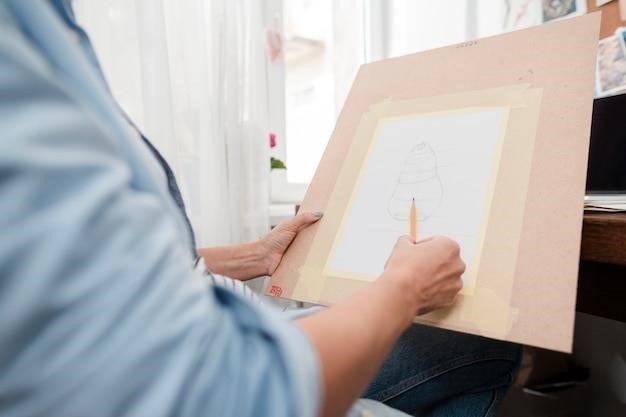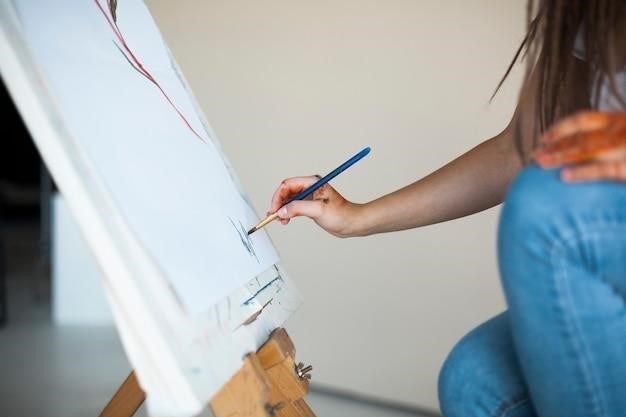Instructional Drawing⁚ A Comprehensive Guide
Instructional drawing leverages visual communication to enhance understanding and learning․ It simplifies complex concepts‚ making them accessible through clear‚ concise illustrations․ This guide explores diverse techniques‚ from basic sketching to advanced shading‚ fostering effective visual learning across various subjects and skill levels․ Mastering these techniques empowers educators and students alike․
Basic Drawing Techniques
Fundamental drawing skills form the bedrock of any artistic endeavor․ Mastering these techniques unlocks the ability to translate observations and ideas onto paper․ Begin with simple shapes⁚ circles‚ squares‚ and triangles‚ practicing their variations in size and orientation․ This exercise develops hand-eye coordination and control․ Next‚ focus on line weight and texture‚ experimenting with light and heavy strokes to create depth and visual interest․ Learn to accurately depict contours‚ the outlines of objects‚ paying attention to their curves and angles․ Basic shading techniques‚ such as hatching and cross-hatching‚ introduce light and shadow‚ adding volume and realism to your drawings․ Practice these fundamental techniques regularly to build confidence and fluency in your artistic expression․ Remember‚ consistent practice is key to improvement․ Start with simple subjects and gradually increase complexity․ Observe the world around you meticulously to understand form and structure․ These basic techniques are the building blocks upon which more advanced drawing skills are built․
Shading and Tonal Techniques
Shading and tonal techniques are crucial for adding depth‚ dimension‚ and realism to drawings․ They involve manipulating light and dark values to create the illusion of three-dimensionality on a two-dimensional surface․ Begin by understanding the principles of light and shadow⁚ how light falls on an object‚ creating highlights‚ mid-tones‚ and shadows․ Mastering basic shading techniques‚ such as hatching‚ cross-hatching‚ and stippling‚ is essential․ Hatching uses parallel lines‚ cross-hatching uses intersecting lines‚ and stippling uses dots to create tonal variations․ Blending techniques‚ using smudging tools or fingers‚ soften transitions between values‚ creating smooth gradations․ Experiment with different shading tools‚ including pencils of varying hardness‚ charcoal‚ and pastels‚ to explore diverse textures and effects․ Practice observing how light affects objects in real life‚ paying close attention to the subtle changes in value and tone․ Accurate rendering of light and shadow significantly enhances the realism and visual appeal of any drawing․ These techniques allow for the creation of convincing forms and a greater sense of depth․
Advanced Drawing Techniques
Beyond fundamental skills‚ advanced drawing techniques elevate artistry; Perspective drawing‚ crucial for realism‚ involves creating the illusion of depth and three-dimensional space on a flat surface․ Mastering one-point‚ two-point‚ and three-point perspective allows for accurate representation of architectural structures‚ landscapes‚ and interiors․ Understanding vanishing points and converging lines is key․ Detailed rendering techniques‚ including the use of textures and patterns‚ add realism and visual interest․ Experiment with different mediums like charcoal‚ pastels‚ and colored pencils to explore varied textures and effects․ Advanced shading techniques‚ such as chiaroscuro (strong contrasts between light and shadow)‚ and sfumato (smoky‚ hazy effects)‚ enhance depth and mood․ Figure drawing‚ a challenging yet rewarding area‚ requires understanding anatomy and proportion․ Practice from life or using anatomical references to accurately depict human forms․ Composition techniques‚ including the rule of thirds and leading lines‚ enhance visual impact and storytelling within the artwork․ Continuous practice and experimentation are vital to mastering these advanced techniques and developing a unique artistic style․

The Importance of Observation in Drawing
Accurate observation is foundational to successful drawing․ Careful study of form‚ light‚ shadow‚ and detail translates to realistic and engaging artwork․ Observational skills are honed through dedicated practice and mindful attention to the subject․ This process enhances visual literacy and artistic expression․
Observational Drawing Exercises
Enhance your observational drawing skills through a series of structured exercises․ Begin with simple forms like basic geometric shapes—cubes‚ spheres‚ cylinders—paying close attention to their proportions and how light interacts with their surfaces․ Progress to more complex objects‚ still lifes arranged with varied shapes‚ textures‚ and light sources․ Time yourself for short‚ focused studies to improve quick perception․ Practice contour drawing‚ focusing on the outline and the relationships between forms without shading․ Gradually incorporate shading techniques to create depth and volume․ Remember to break down complex forms into simpler shapes to better understand their structure․ Don’t be afraid to make mistakes; they are integral to the learning process․ Regular practice and dedicated observation will yield significant improvements in your drawing accuracy and skill․
Developing Observational Skills
Cultivating keen observational skills is paramount for any artist․ Start by training your eye to perceive subtle details often overlooked․ Practice mindful looking‚ focusing intently on your subject‚ noting its nuances of form‚ texture‚ and value․ Engage all your senses; how does the object feel‚ smell‚ or sound? These sensory inputs enrich your understanding and translate into more expressive drawings․ Break down complex scenes into simpler shapes‚ identifying the underlying structures․ Compare and contrast different elements within your subject; how do colors‚ lines‚ and forms relate? Regularly practice drawing from life‚ focusing on various subjects—still lifes‚ landscapes‚ portraits—to diversify your observational abilities․ Analyze the work of master artists; observe how they capture form‚ light‚ and shadow․ Consistent practice and mindful observation will sharpen your perceptual abilities‚ leading to more accurate and insightful drawings․

Teaching Drawing Techniques Effectively
Effective drawing instruction blends foundational skills with creative exploration․ A structured curriculum‚ adaptable to diverse skill levels‚ fosters confidence and encourages individual expression․ Patience and positive reinforcement are key to student success in mastering drawing techniques․
Curriculum Design for Drawing Instruction
A well-structured curriculum for drawing instruction should progress logically‚ building upon foundational skills․ Begin with basic techniques like sketching and line control‚ gradually introducing more complex concepts such as shading‚ perspective‚ and composition․ The curriculum should incorporate a variety of mediums‚ allowing students to explore different textures and effects․ Consider incorporating observational drawing exercises to hone observation skills and the ability to translate three-dimensional forms onto a two-dimensional surface․ Incorporate opportunities for students to develop their own individual styles and approaches․ Regular assessments‚ both formative and summative‚ can track student progress and identify areas needing further attention․ The inclusion of projects that allow for creativity and self-expression is crucial to maintaining student engagement and fostering a love of the art form․ Remember to cater to different learning styles and paces‚ ensuring that all students feel supported and challenged․ This holistic approach ensures a comprehensive learning experience that develops both technical proficiency and artistic vision․ Encourage exploration of various art historical styles and influences to broaden understanding and encourage creativity․ Finally‚ provide opportunities for peer review and constructive criticism to enhance learning and skill development․
Adapting Instruction for Different Skill Levels
Effective drawing instruction necessitates adapting teaching methods to accommodate diverse skill levels within a classroom setting․ Beginners may require more focused attention on fundamental techniques like line control‚ basic shapes‚ and simple shading exercises․ These foundational skills provide a solid base for more advanced concepts․ Intermediate students can delve into more complex techniques such as perspective‚ composition‚ and detailed rendering․ Introduce them to a wider range of mediums and encourage experimentation with different styles․ For advanced students‚ focus on refining their existing skills‚ exploring advanced techniques like detailed anatomy studies or complex light and shadow manipulations․ Challenge them with ambitious projects that push their creative boundaries․ Differentiation can involve adjusting the complexity of assignments‚ providing varied levels of support‚ and offering opportunities for individualized instruction․ Consider using a variety of teaching methods‚ including demonstrations‚ guided practice‚ independent work‚ and peer learning․ Regular assessment helps to identify individual strengths and weaknesses‚ guiding the adaptation of instruction to meet individual student needs; Creating a supportive and inclusive classroom environment encourages students of all skill levels to participate actively and confidently․ Remember that progress varies‚ so celebrate each student’s achievements and foster a growth mindset․